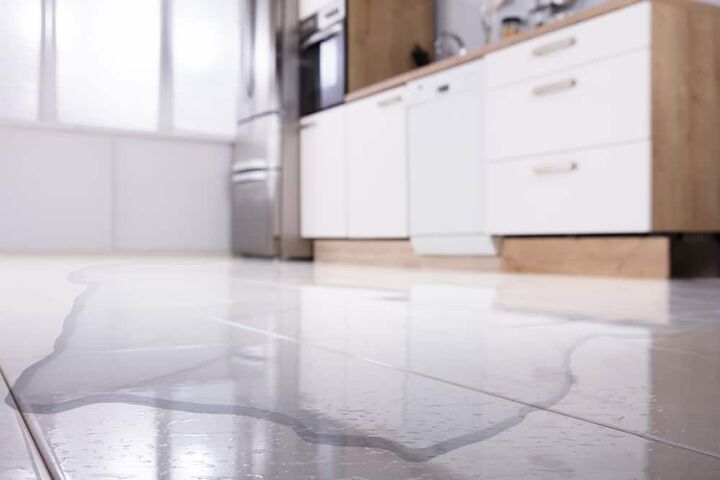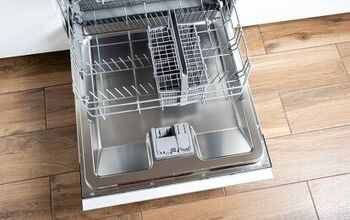KitchenAid Dishwasher Leaking? (Possible Causes & Fixes)

Dishwashers have become a staple of just about any modern kitchen in the United States. They make cleanup a snap regardless of how big dinner was. And that level of convenience cannot be understated, especially when having to wash the dishes by hand.
KitchenAid makes some of the most recognizable lines of kitchen appliances around. That doesn’t mean they are impervious to leaking, though. When a KitchenAid dishwasher starts to leak, it could be due to the water inlet valve, wash arm assembly, door seal, door gasket, and more. It is important to troubleshoot the issue before hoping to implement a fix.
Do You Need Appliance Repair Services?
Get free, zero-commitment quotes from pro contractors near you.

Water Inlet Valve
Perhaps the most common issue behind a leaking KitchenAid dishwasher is the water inlet valve. The role of the inlet valve is to open up so that water can enter the dishwasher. When the valve gets stuck open or breaks, then the dishwasher will keep filling with water until it either overflows or leaks.
The fix. Unfortunately, if the water inlet valve is damaged, it will need to be replaced as there is no repairing it. If it is stuck open, you can try to return it to the closed position, but there is a chance that it will not work properly going forward and will need replacing.
Wash Arm Assembly
The wash arm assembly is responsible for spraying water throughout the dishwasher. The pressurized spray is meant to break down grime and food leftover on the dishes. The arm assembly also has three different sections: the center, lower, and upper arm assembly.
- Center wash arm assembly. When the wash arm becomes damaged or cracked, water can spray in a jet towards the seal of the door. Check to see if there is damage and replace it should you notice any cracking or damage.
It is important that you do not seal that crack with an adhesive, particularly glue. The glue will break down over time. Should there be no damage, check that the screws are tight. When the screws are loose, water can leak from underneath the dishwasher door.
- Lower wash arm assembly. It is important to note that, when any portion of the arm assembly is damaged or cracked, leaking possible. The location of the damage is what dictates where the leaking will occur. Like the center arm, check for obvious signs of damage or loose screws and make the appropriate correction.
- Upper wash arm assembly. The final portion of the arm assembly. Check for surface damage or loose screws and correct the issue accordingly. Damage to any portion of the arm assembly will spray water on the door seal, ultimately causing a leak.
Door Gasket or Seal
Inspect the door gasket and seal, looking for any gaps, cuts, or tears that could potentially allow for leaking. There is actually a simple test to ensure that the door gasket is making the proper contact. Close the door over top of a dollar bill. If the bill doesn’t stick, then there is a gap.
When there is a gap or damage to the gasket, replace it. If the gasket is doing its job and there is still a leak, then check on the door hinges instead. The hinges can get bent, preventing the door from closing properly. Replace the rims if you notice that they are bent or damaged.
Note the Leak Location
It is important that you note where the leak is coming from. This can be a telltale sign of where the problem is. In the problems outlined above, the issues result in leaking that happens around the door or pooling water underneath of the unit.
Leaking Coming from Behind the Dishwasher
Should you notice that there is leaking emanating from behind the dishwasher, then you are facing a different issue entirely. It could be the aforementioned water inlet valve, but there are two other issues that could cause leaking at the back of the unit.
Water pump. Take a look at the clamp that connects the pump to the water hose. You might notice signs of wear and tear or even cracks forming in the hose. In rarer instances, you may notice damage to the water pump.
Should you notice that the pump is damaged or even burnt, it should be replaced entirely. The water pump cannot be repaired. Some KitchenAid dishwashers also have a pump model that is used to drain and supply water. When the drain pump is broken, it can also lead to leaking or overflowing.
Damaged hose. The water pump is generally not going to be at fault. If anything, you are probably going to notice damage to the hose. It could even be unscrewed, which is a quick and easy fix. Vibration and stress on the hose can unscrew the clamp, causing it to come loose.
What is the Most Common Cause of a Dishwasher Leaking?
More often than not, your dishwasher is leaking due to the door gasket. The simplest way is to open the dishwasher door and take a look at the seal around the door. If you notice that it is excessively worn or damaged, simply replace the gasket and try again.
The quickest indicator of a faulty gasket is that water pools in front of the dishwasher or even drips down the door itself. While there can be other issues, the gasket is the place to start and will usually provide the quickest fix.
When is a Dishwasher Worth Fixing?
There will come a time where your dishwasher will break, and you will have to decide whether to fix it or replace it. Some issues can be quite costly to fix if they are fixable at all. Some fixes can be implemented by do-it-yourself types, with the cost of the part the only thing to consider.
But those repairs that require professional intervention may be too expensive to justify. That is when you need to determine whether or not to get it fixed or simply move on and buy a new one. There are three factors in particular that can help you to determine which direction to go. Budget may seem like the most important factor, but there are a few other things to keep in mind when deciding whether or not to get your dishwasher fixed or to simply replace the whole thing.
Do You Need Appliance Repair Services?
Get free, zero-commitment quotes from pro contractors near you.

The Most Important Factors When Determining Whether to Repair or Replace
Warranty. Should your dishwasher still have a warranty on it, fixing may be the best way to go. It might be a hassle, though, because you will have to find a repair shop that is under warranty. Still, you can save a ton of money this way. Warranties may seem like a waste of money, but when you need them, they will leave you breathing a sigh of relief.
Age of the dishwasher. It also depends on just how old the dishwasher is. If it is something newer, you probably would not want to invest in a new one. In that instance, a repair would make more sense. But if your dishwasher is an older model, one pushing 10 years or so, you could be reaching the end of the lifespan anyway. Besides, newer dishwashers are more efficient than the older models, so it could be time to make the upgrade.
Repair type. This is perhaps the most important thing. Quick fixes – stuff like a pressure switch or door latch – can generally be repaired without costing an arm and a leg. It is when you get into the more costly parts like a motor or circulation pump that things come into question. Those parts alone can make it less than economical and that’s not even factoring in the labor required to have it replaced and installed.
Repair cost. This is what most people tend to look at. Look at the costs involved in the repair versus what is required to buy a new unit. The repair cost should come in at under 50 percent of what the cost of a new model would be. If the repair is over that mark, investing in a new model may be the best bet.

Ryan Womeldorf has more than a decade of experience writing. He loves to blog about construction, plumbing, and other home topics. Ryan also loves hockey and a lifelong Buffalo sports fan.
More by Ryan Womeldorf



























